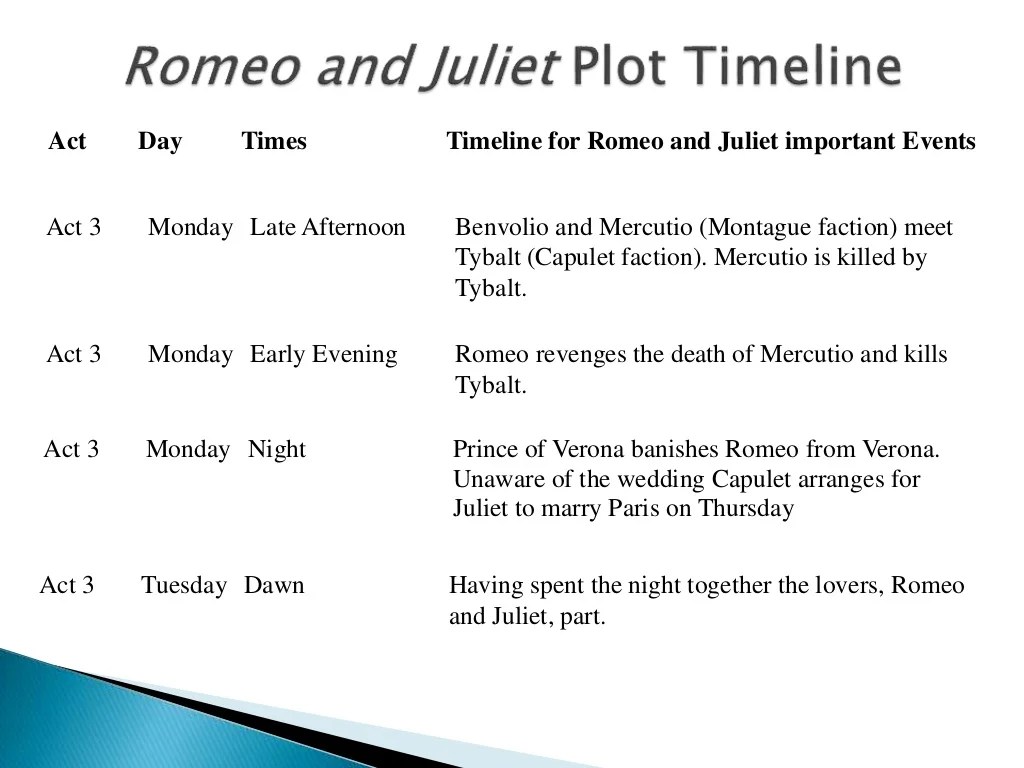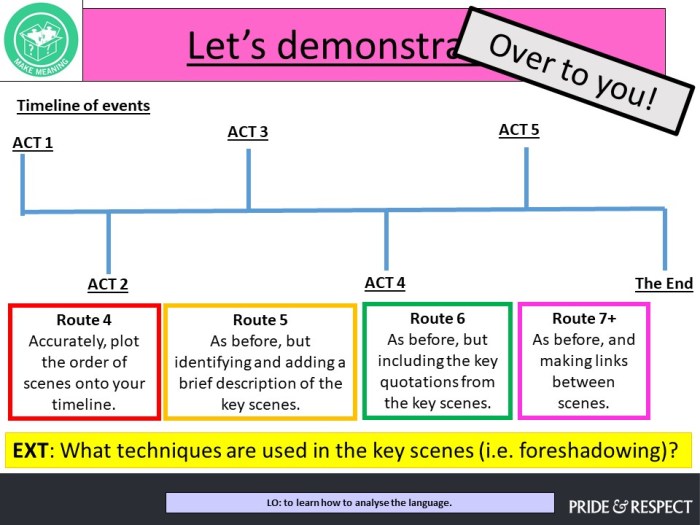In the realm of timeless love stories, the timeline of Romeo and Juliet stands out as a poignant and tragic masterpiece. From their fateful encounter to their untimely demise, their journey unfolds through a series of pivotal events that shape their destiny and leave an enduring impact on readers.
This literary masterpiece delves into the depths of love, family feuds, and the consequences of impulsive actions, weaving a narrative that captivates and moves audiences to this day.
Timeline of Events

The tragic love story of Romeo and Juliet unfolds over a short but eventful period, marked by a series of key events that shape the fate of the star-crossed lovers.
The timeline of events provides a chronological overview of these pivotal moments, highlighting the significant plot points and turning points that lead to the tragic climax.
Initial Meeting
- Romeo Montague attends a masked ball at the Capulet household.
- He meets Juliet Capulet and they instantly fall in love.
Secret Marriage
- With the help of Friar Laurence, Romeo and Juliet secretly marry.
- Their union is kept hidden from their feuding families.
Tybalt’s Death
- Tybalt, Juliet’s cousin, challenges Romeo to a duel.
- Romeo kills Tybalt in self-defense.
Romeo’s Banishment
- For killing Tybalt, Romeo is banished from Verona.
- He is forced to leave Juliet behind.
Juliet’s “Death”
- Friar Laurence gives Juliet a potion that makes her appear dead.
- He plans to reunite her with Romeo once the feud has subsided.
Romeo’s Return
- Unaware of Juliet’s plan, Romeo returns to Verona.
- He finds her apparently dead and takes his own life.
Juliet’s Awakening
- Juliet awakens to find Romeo dead beside her.
- Heartbroken, she stabs herself with his dagger.
Tragic Revelation
- The Montagues and Capulets discover the bodies of their children.
- Friar Laurence reveals the secret marriage and the tragic events that led to their deaths.
The timeline of events in Romeo and Juliet highlights the pivotal moments that shape the destiny of the star-crossed lovers, leading to their tragic demise and the reconciliation of their feuding families.
Character Development over Time: Timeline Of Romeo And Juliet

Romeo and Juliet undergo significant transformations throughout the play. Initially, they are both naive and impulsive, but their love for each other forces them to mature and face the consequences of their actions.
Romeo’s Development
- Initial Impulsivity:Romeo is initially infatuated with Rosaline and acts impulsively when he meets Juliet.
- Maturation Through Love:His love for Juliet teaches him the true meaning of love and responsibility.
- Tragic Hero:Romeo’s impulsive nature ultimately leads to his downfall, making him a tragic hero.
Juliet’s Development
- Naive and Obedient:Juliet is initially obedient to her parents and the expectations of society.
- Independent and Defiant:Her love for Romeo forces her to defy her family and society.
- Martyr for Love:Juliet ultimately sacrifices her life for her love, demonstrating her unwavering devotion.
External Factors Influencing Their Growth
Romeo and Juliet’s relationship is heavily influenced by external factors, including:
- Family Feud:The feud between the Montagues and Capulets creates a hostile environment for their love.
- Societal Expectations:The expectations of society, including arranged marriages, hinder their relationship.
- Fate and Fortune:The play suggests that Romeo and Juliet’s love is doomed from the start, as fate conspires against them.
Use of Foreshadowing

Foreshadowing is a literary device used to hint at future events, creating a sense of anticipation and suspense. In Romeo and Juliet, Shakespeare employs foreshadowing techniques to build tension and foreshadow the tragic outcome.
Romeo and Juliet’s love story is filled with drama, tragedy, and timeless themes. For those seeking further insight into the play, a resource like The Potter’s Kiln Act Answers can provide valuable analysis and interpretations. Returning to the timeline of Romeo and Juliet, the play’s events unfold over a mere five days, highlighting the swift and intense nature of their forbidden love.
One notable instance of foreshadowing occurs in the prologue, where the Chorus states, “Two households, both alike in dignity, / In fair Verona, where we lay our scene, / From ancient grudge break to new mutiny, / Where civil blood makes civil hands unclean.”
Foreshadowing of Violence and Conflict
- The mention of “ancient grudge” and “civil blood” suggests a long-standing conflict between the Montagues and Capulets, hinting at the potential for violence and bloodshed.
- The phrase “makes civil hands unclean” implies that the conflict will lead to acts of violence and bloodshed, as friends and family turn against each other.
Foreshadowing of Love and Tragedy
- The prologue also foreshadows the doomed love between Romeo and Juliet, stating, “From forth the fatal loins of these two foes / A pair of star-cross’d lovers take their life.”
- The use of the term “star-cross’d” suggests that the lovers’ fate is determined by forces beyond their control, hinting at the tragic outcome of their relationship.
Foreshadowing Through Dreams and Omens, Timeline of romeo and juliet
- In Act 1, Scene 4, Romeo has a premonition of his death after meeting Juliet at the Capulet ball, stating, “My mind misgives / Some consequence yet hanging in the stars / Shall bitterly begin his fearful date / With this night’s revels.”
- Juliet also experiences a dream in Act 3, Scene 5, where she sees Romeo lying dead in a tomb, foreshadowing his tragic fate.
Foreshadowing Through Language and Imagery
- Shakespeare uses dark and ominous language throughout the play, such as “death-marked love” and “fatal poison,” hinting at the tragic events to come.
- The imagery of light and darkness also foreshadows the characters’ shifting fortunes, as they move from moments of joy and hope to despair and death.
Through these instances of foreshadowing, Shakespeare creates a sense of foreboding and anticipation, building tension and preparing the audience for the tragic events that unfold.
Symbolism and Motifs

The play employs potent symbols and motifs to reinforce its central themes and deepen characterization.
Love and Death:The play intertwines love and death, exploring their paradoxical relationship. The lovers’ passionate connection is juxtaposed with the tragic events that lead to their demise, highlighting the destructive power of unbridled passion.
The Rose
- The rose represents beauty, love, and passion.
- Juliet’s comparison to a rose in Act II, Scene II, symbolizes her youthful innocence and beauty.
- However, the thorns on the rose foreshadow the tragic consequences of their love.
The Night
- The night symbolizes secrecy, danger, and the hidden forces at play.
- Many crucial events occur under the cover of darkness, such as the lovers’ secret meetings and the tragic deaths.
- The night amplifies the play’s themes of passion, violence, and fate.
The Ladder
- The ladder represents the connection between Romeo and Juliet, as well as their hope for a future together.
- When Romeo uses the ladder to climb to Juliet’s balcony, it symbolizes his willingness to risk everything for love.
- However, the ladder’s subsequent use by Paris to enter Juliet’s tomb underscores the fragility of their love and the tragic consequences of their actions.
Dramatic Structure

Romeo and Juliet is a classic tragedy that follows the five-act dramatic structure. The play’s structure contributes to its overall impact by creating a sense of suspense, tension, and inevitability.
The expositionintroduces the characters and the setting of the play. We learn about the feud between the Montagues and Capulets, and we meet Romeo and Juliet. The rising actionbegins when Romeo and Juliet meet at a party and fall in love.
The climaxof the play occurs when Romeo kills Tybalt, Juliet’s cousin. The falling actionbegins when Romeo is banished from Verona. The resolutionof the play occurs when Romeo and Juliet die.
Exposition
The exposition of Romeo and Juliet is brief but effective. It establishes the setting of the play in Verona, Italy, and introduces the two main characters, Romeo Montague and Juliet Capulet. The exposition also introduces the conflict between the Montagues and Capulets, which will drive the plot of the play.
Rising Action
The rising action of Romeo and Juliet begins when Romeo and Juliet meet at a party and fall in love. Their love is forbidden, however, because of the feud between their families. Despite the obstacles, Romeo and Juliet continue to meet in secret.
The rising action builds to a climax when Romeo kills Tybalt, Juliet’s cousin. This event leads to Romeo’s banishment from Verona.
Climax
The climax of Romeo and Juliet occurs when Romeo kills Tybalt. This event is the turning point of the play, and it leads to a series of tragic events. Romeo is banished from Verona, and Juliet is forced to marry Paris.
Romeo and Juliet decide to take their own lives rather than live without each other.
Falling Action
The falling action of Romeo and Juliet begins when Romeo is banished from Verona. Juliet is forced to marry Paris, but she takes a potion that makes her appear dead. Romeo returns to Verona and finds Juliet seemingly dead. He takes his own life, and Juliet awakens to find Romeo dead.
She then takes her own life.
Resolution
The resolution of Romeo and Juliet occurs when Romeo and Juliet die. Their deaths end the feud between the Montagues and Capulets. The play ends with a chorus that laments the deaths of Romeo and Juliet and calls for peace.
Answers to Common Questions
What is the significance of the timeline in Romeo and Juliet?
The timeline provides a chronological framework for the play’s events, highlighting the rapid succession of events that lead to the tragic outcome.
How does the timeline contribute to the play’s dramatic tension?
The compressed timeline creates a sense of urgency and inevitability, heightening the dramatic tension as the characters race against time to resolve their conflicts.
